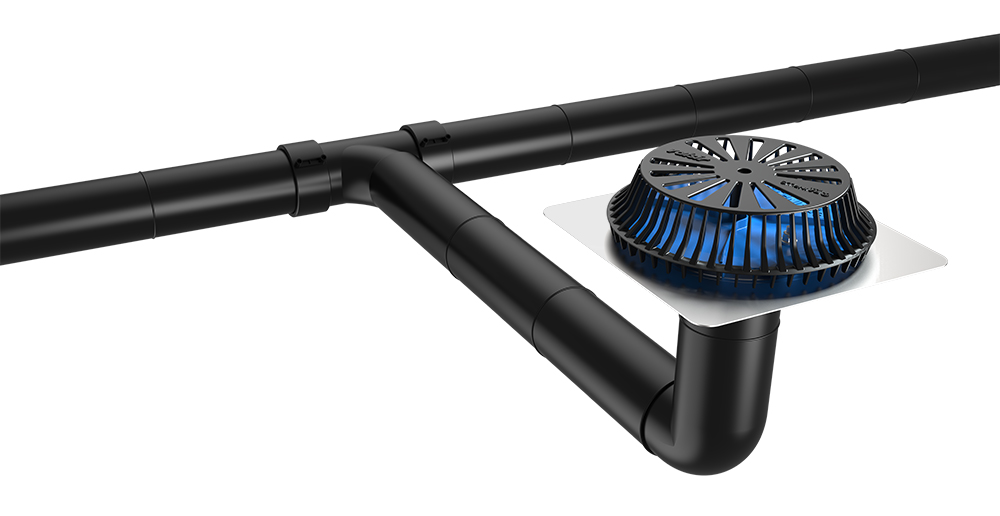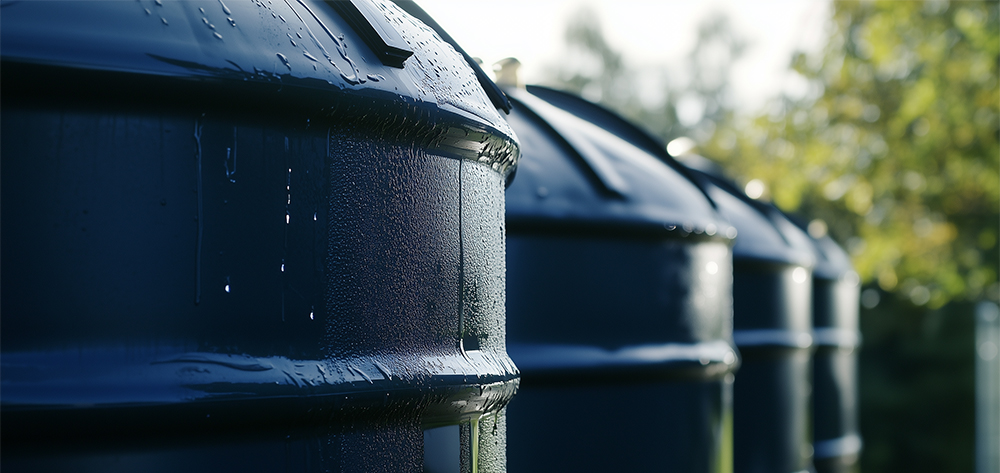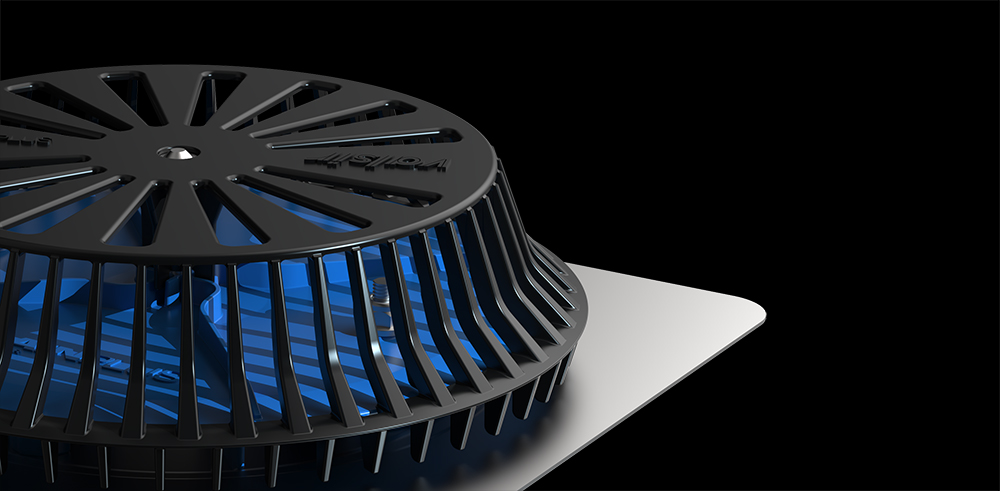Proper rainwater management is now more important than ever for modern buildings. The increase in extreme rainfall events, such as so-called ‘water bombs’, requires the adoption of advanced drainage systems that can respond effectively, safely and sustainably. Rainwater collectors are a fundamental part of these systems, contributing to the collection, conveyance and, where possible, recovery of rainwater.
Within a drainage system, collectors are not just passage elements: they are strategic points for optimising runoff. Their correct sizing and positioning directly affects the overall performance of the entire system.
What are rainwater collectors?
Rainwater collectors are devices installed to collect rainwater that flows from roofs or impermeable surfaces, conveying it to a disposal or storage system. These components are designed to withstand the elements, filter debris and ensure smooth drainage, even in heavy rain.
In more advanced systems, such as Rainplus, collectors are also known as captors. These are the first point of water collection and work in synergy with pipes specially designed to facilitate rapid water flow, even horizontally, without the need for slopes.

Function of rainwater collectors in a siphonic system
Within a siphonic system such as Rainplus, the collectors play a highly technological role. They do not just collect water: they contribute to triggering the siphon effect, a physical phenomenon that allows the pipes to work at full capacity, increasing flow rate and speed of drainage.
The system works thanks to the configuration of the collectors, which prevent air from entering and facilitate negative pressure inside the pipes. In this way, even in horizontal sections, water moves quickly towards the outlet, without the need for steep slopes or bulky vertical columns.
The Rainplus system: innovation in rainwater drainage
Rainplus is one of the most advanced solutions for rainwater drainage in medium and large buildings. Designed to cope with the most intense weather conditions, the system is based on an intelligent combination of collectors, HDPE pipes and applied hydraulics principles.
It works on the siphon principle: when the pipes are completely full, the column of water flowing down creates a vacuum that accelerates the flow even in the horizontal sections. The result is a more compact, efficient and quieter system than traditional gravity-fed systems.
Rainwater collector: how it contributes to the efficiency of the system
The position of the rainwater collectors is crucial: they are installed directly at the collection points (such as gutters or flat roofs) and connected to the main collector by short sections of pipe. This architecture makes it possible to reduce the number of waste columns and adapt the system to the structure of the building without the need for invasive work.
Another fundamental aspect is the possibility of conveying the collected water to storage tanks or cisterns, allowing it to be reused for non-potable purposes such as irrigation or filling fire-fighting tanks. A well-designed system with Rainplus collectors is therefore also a concrete step towards more sustainable construction.

Environmental and economic advantages of Rainplus collectors
The use of Rainplus collectors offers numerous benefits, both from an environmental and economic point of view. The possibility of using smaller diameter pipes, fewer collectors and a more streamlined system significantly reduces installation costs. Installation times are also shorter, with advantages for the construction site.
From an environmental point of view, the materials used, such as HDPE and stainless steel, are fully recyclable. Our production processes are geared towards energy saving and emission reduction, in line with the criteria of the Green Building Council.
Rainplus is not simply a system of collectors for rainwater: it is a technology capable of preventing damage caused by the most violent and sudden rainfall, while simultaneously collecting and recovering large quantities of rainwater that would otherwise be wasted.
Intelligent accessories: overflow kit and green covers
The Rainplus system can be integrated with accessories designed to increase the safety and functionality of the system. One of the most important is the overflow kit, which only comes into operation during exceptional rainfall, protecting the building from potential flooding.
Another innovation is the green roof kit, which allows rainwater collectors to be installed in roofs covered with plants and vegetation without the risk of clogging due to debris or soil. Even in these contexts, the collectors maintain large hydraulic performance.
How to choose the most suitable collector for rainwater harvesting
Choosing the right collector depends on several factors: the surface area to be drained, the type of roof, the height of the building, the required flow rate and the space available. The Rainplus system offers two main models: the compact and versatile Rainplus 56-S and the Rainplus 110-S, suitable for large flow rates of up to 65 l/s.
Both models are available in several configurations to suit metal gutters or flat roofs with waterproofing membranes. The versions with perforated plate are designed for perfect integration with bituminous membranes.
Installation and maintenance of rainwater collectors
One of the great strengths of the Rainplus system is its ease of installation. The collectors are fixed directly to the roof and connected to the pipes by butt welding or electrofusion. The light weight of HDPE simplifies on-site operations and reduces the need for complex equipment.
From a maintenance point of view, the collectors are equipped with leaf guards that prevent debris from entering. The high flow velocity ensures a self-cleaning effect, reducing the frequency of cleaning.

Why choose the Rainplus system
Choosing a system such as Rainplus means adopting a technology that has been tested, engineered to the most stringent standards (EN 1253) and supported by a sustainable vision. We have designed every component of the system to last, reduce waste and improve the performance of modern buildings.
At a time when climate resilience and environmental sustainability are priority objectives, relying on a system that allows rainwater recovery is a winning choice from every point of view.
A safer and more sustainable future for urban drainage
Rainwater collection collectors are much more than simple drainage elements: they represent the pinnacle of an intelligent system designed to protect, optimise and sustain the environment. Rainplus is a modern, efficient and adaptable solution that responds to climate challenges with superior performance and a minimal ecological footprint.
FAQ
- Can rainwater collectors be installed in existing buildings?
Yes, the Rainplus system is also suitable for renovations, with minimally invasive solutions. - What are the differences between the Rainplus 56-S and 110-S models?
The 56-S is more compact and suitable for small spaces; the 110-S handles larger flow rates. - How are Rainplus collectors cleaned?
Thanks to the speed of the flow and the anti-leaf grid, the collectors are self-cleaning and require little maintenance. - Are Rainplus collectors compatible with green roofs?
Yes, using the special green roof kit that prevents clogging from soil and plants. - Can the collectors be connected to tanks for water reuse?
Absolutely. Rainplus is ideal for conveying rainwater to storage tanks for non-potable uses.
 Italiano
Italiano
 English
English
 Deutsch
Deutsch
 Français
Français
 Español
Español
 Greek
Greek